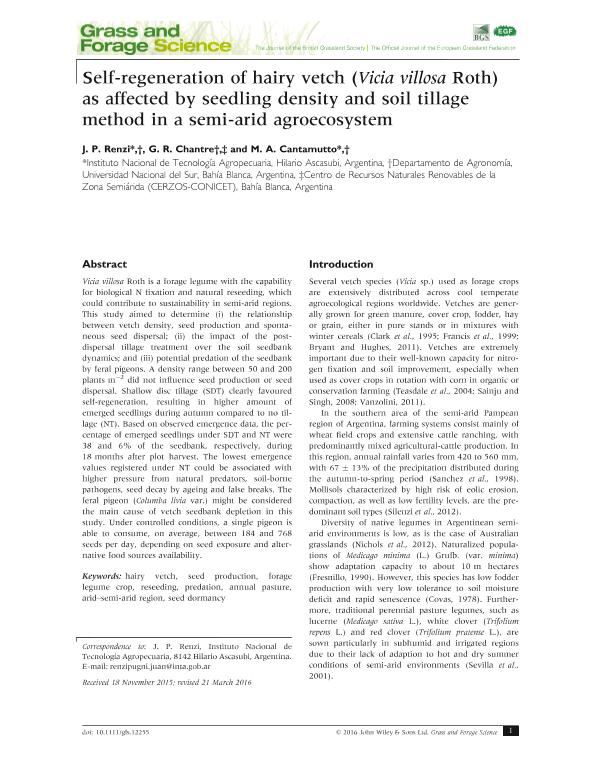Artículo
Self-regeneration of hairy vetch (Vicia villosa Roth) as affected by seedling density and soil tillage method in a semi-arid agroecosystem
Fecha de publicación:
09/2017
Editorial:
Wiley
Revista:
Grass and Forage Science
ISSN:
0142-5242
Idioma:
Inglés
Tipo de recurso:
Artículo publicado
Clasificación temática:
Resumen
Vicia villosa Roth is a forage legume with the capability for N biological fixation and natural reseeding, which could contribute to the sustainability in semi-arid regions. The present study aimed to determine (i) the relationship between vetch density, seed production and spontaneous seed dispersal; (ii) the impact of the post dispersal tillage treatment over the soil seedbank dynamics; and (iii) potential predation of seedbank by pigeons. A density range between 50 and 200 plants m-2 did not influence seed production or seed dispersal. Shallow disk tillage (SDT) clearly favoured self-regeneration, resulting in higher amount of emerged seedlings during autumn compared to no-tillage (NT). Based on observed emergence data, the percentage of emerged seedlings under SDT and NT were 38 and 6% of the seedbank, respectively, during 18 months after plot harvest. The lowest emergence values registered under NT could be associated to a higher pressure of natural predators, soil-borne pathogens, seed decay by ageing and false breaks. The feral pigeon (Columba livia var.) might be considered the main cause of vetch seedbank depletion in the present study. Under controlled conditions, a single pigeon is able to consume, in average, between 184 and 768 seeds per day, depending of seed exposure and alternative food sources availability.
Archivos asociados
Licencia
Identificadores
Colecciones
Articulos(CERZOS)
Articulos de CENTRO REC.NAT.RENOVABLES DE ZONA SEMIARIDA(I)
Articulos de CENTRO REC.NAT.RENOVABLES DE ZONA SEMIARIDA(I)
Citación
Renzi, Juan Pablo; Chantre Balacca, Guillermo Ruben; Cantamutto, Miguel Ángel; Self-regeneration of hairy vetch (Vicia villosa Roth) as affected by seedling density and soil tillage method in a semi-arid agroecosystem; Wiley; Grass and Forage Science; 72; 3; 9-2017; 524-533
Compartir
Altmétricas




